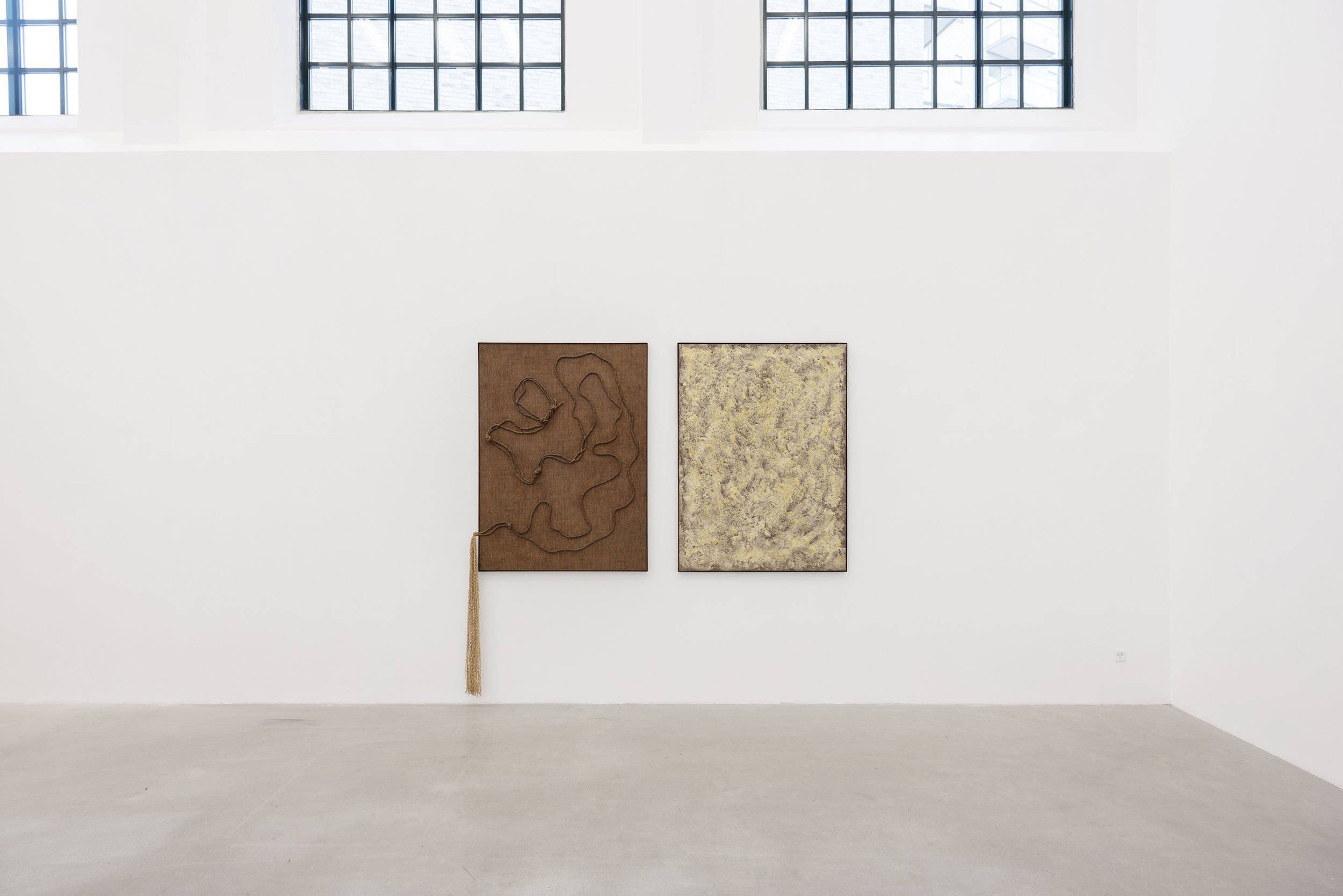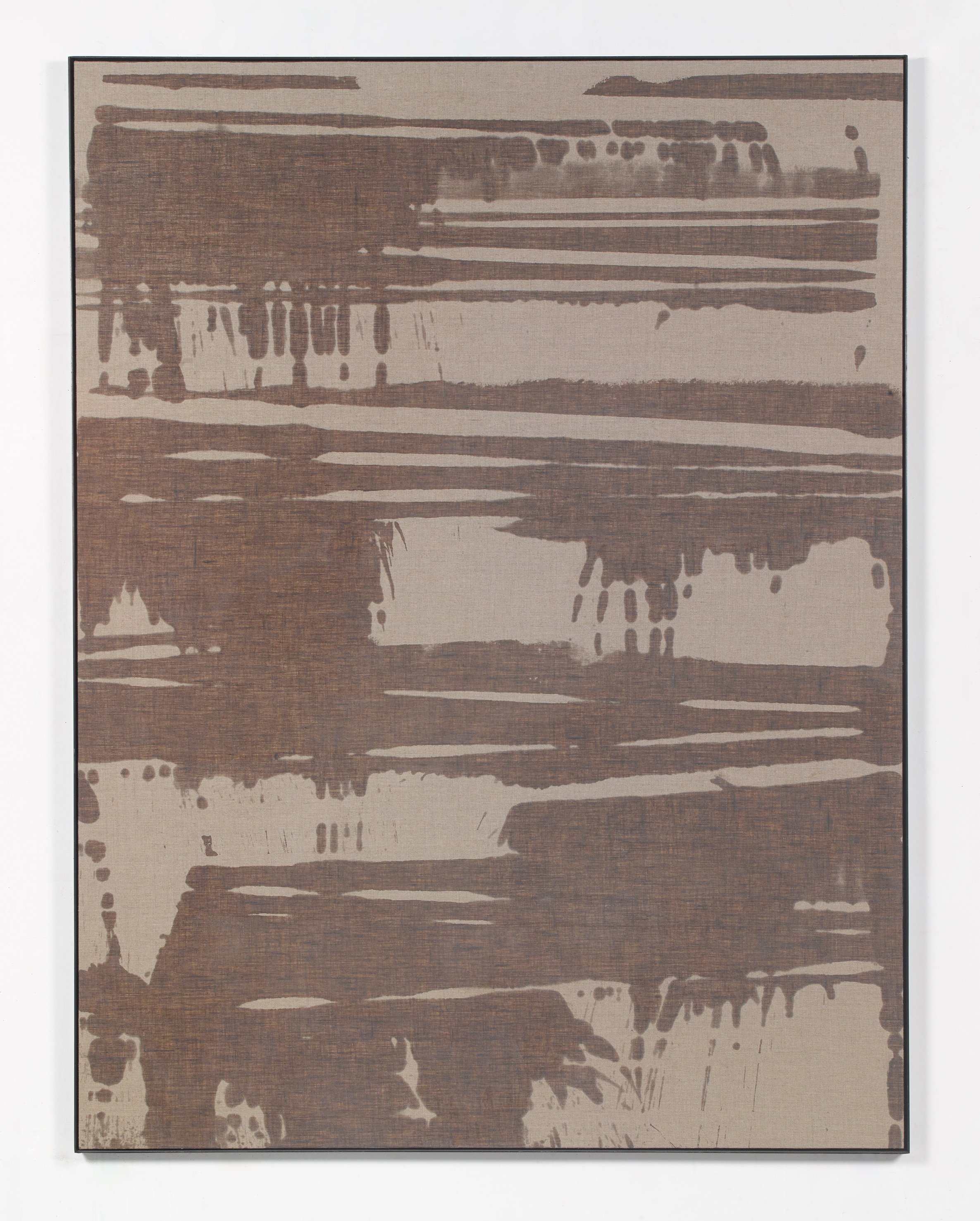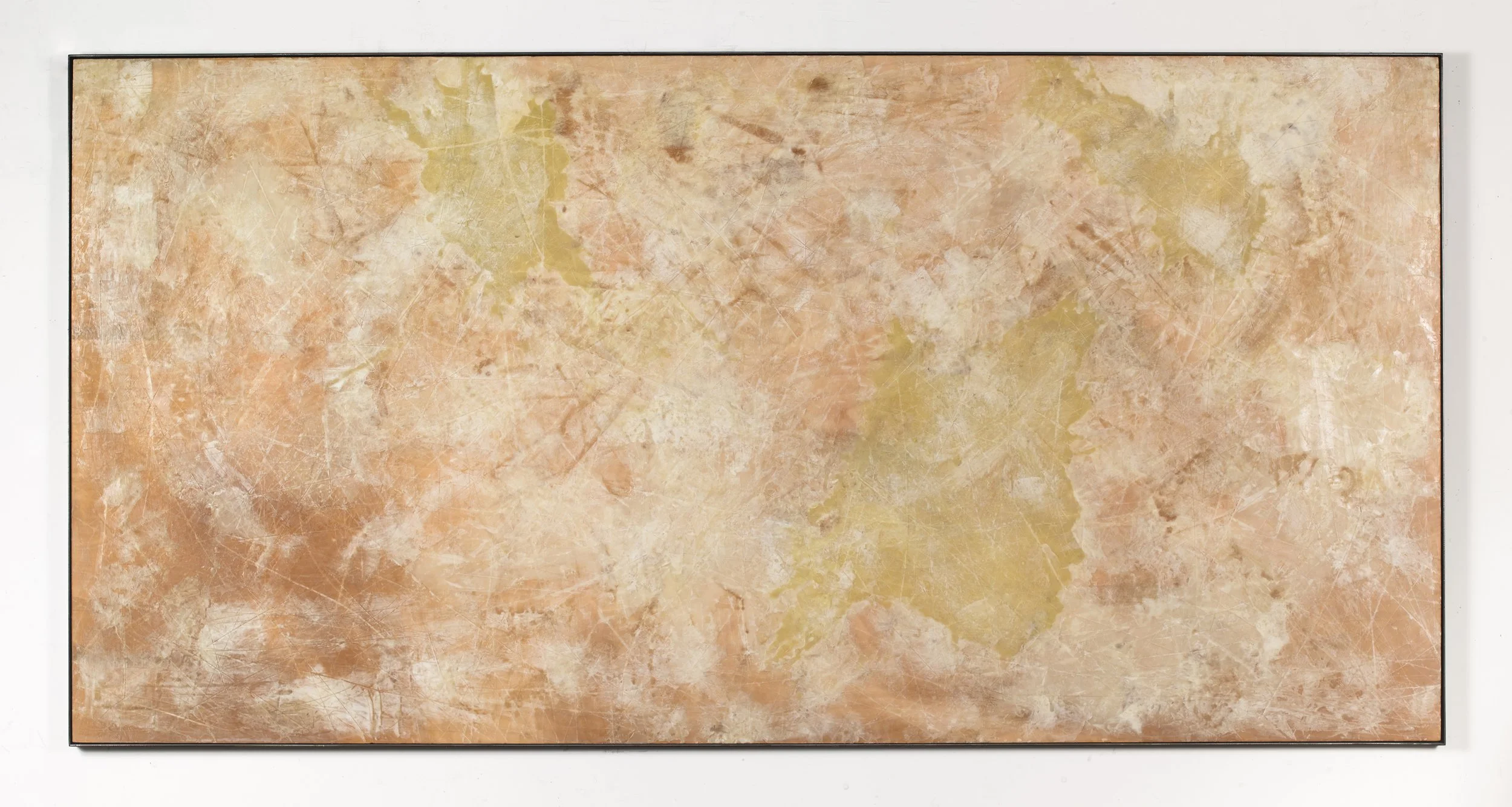Nick Theobald
The Fountain
11 May - 8 June 2019
IN THE SHADOW OF THE KALI YUGA
“Honey, this is honey, the speech of thy tongue is honey; in my mouth lives the honey of the bee, in my teeth lives peace.” —Deccan Hindu vow
Honeybees make love to the world. They can do nothing more or less than this. Humans follow suit, only they’re not aware of this yet. They think they destroy the world. Sometimes this is true. According to Hindu prophecy, we are in the time of the Kali Yuga—an epoch of nihilism and annihilation, where humans are alienated from their true divine nature. Like a forest fire, humans scorch the earth. Like a forest fire, ash then nourishes soil, creating a womb to cultivate new life.
Over the past ten years, New York-based artist Nick Theobald has made art from beeswax. This medium has its own life, and its own energetic resonance—bees consume honey, which is then metabolized into wax and secreted from their bodies. This wax is chewed to a soft texture by the bees, and subsequently reconstructed into hexagonal vessels that store pollen and honey. When this substance is brought into synchronicity with Theobald’s relationship to the nature of things and the nature of life, it is once again catalyzed. Unlike a true chemical catalyst, however, Theobald is also changed and made new by the reactions inherent in his experimentations.
Theobald processes beeswax by melting it at different temperatures to increase or decrease vis- cosity. For his paintings, he layers the melted wax (which can be cooler and paste-like or oily-hot, and varies in color depending on the diet of the honeybees and location where it was produced) onto wood panels. The story of one wax—deep, burnt umber tones made by bees gathering nec- tar and pollen from buckwheat flowers—is altered by the story of another: a pale, translucent variant made mostly made from lavender, according to the hive’s beekeeper. The multiple strata of shading and texture Theobald creates from these waxes behave something like a palimpsest of altering landscapes; the dark, firework-like explosive figurations on the diptych panels of Utopia Utopia (2018) are absorbed and redressed by quieter shapes in lighter shades, bending the narrative toward something softer and more remote—less earthbound. A faint scrawl of text floats on the surface of the piece—it spells out, twice, the word “utopia,” a domain of beneficent nonexistence. In Assumed Risk (2019), pale, milk-colored wax hovers over a stormy topography of dark and golden tones, recalling cloud dramas. Erased and remade, the stories held in each work become the tales of Scheherazade: complex and enchanting, with each new story disguising the simple wish to remain alive for one more night.
Like cave paintings where representation has evolved, rather than devolved, to abstraction, these surfaces suggest that there may be eternal truths that play themselves out in Theobald’s work. And as with the truest and most enduring forms of storytelling, they appear contemporary, or like they could’ve been made 200 years ago, or fifty years from now, or at the dawn of civilization. In this way, they bend time. This is a reading Theobald encourages. As a devotee of the Tarot de Marseille, Theobald sees the archetypal possibilities in these ambiguous forms, and through them illustrates the core driving principal of our human fable: we are here to find love, inwardly, outwardly, from above and below. This idea of love—where it comes from, and how to find it— pervades the works presented in “The Fountain,” shown in May 2019 at Galleri Jacob Bjørn. For Theobald, one findslove “by being at the heart of your passions, by returning to the fountain,” the same way a bee finds love by continually gathering pollen and bringing it back to the hive, a perpetual gesture that is something like a moving prayer.
In the first of nine lectures on honeybees, philosopher Rudolf Steiner stated that, “One only begins to understand the life of the bees when one knows that the bee lives in an atmosphere completely pervaded by love. On the other hand the bee is quite especially favored by the fact that, in its turn, it feeds upon just those parts of the plants which are also wholly pervaded by love. The bees suck out their food — which they then turn into honey — exclusively from those parts of the plants that are centered in love; they bring, so to speak, the love-life of the flowers into the hive.” Each of the pieces in this exhibition mediate love through both ecstasy and duty, transcending “work,” and existing in the work itself. They are the “chop wood, carry water” of being an artist in the studio, returning day after day to the same hive, gathering the same nectar and making it into something new, over and over again. For Life Line and Anchors and Escapes (both 2019), the artist created three-dimensional paintings by nailing a twisting river of hemp rope to linen canvas, then coating the pieces in dark beeswax. In both pieces, a stream of frayed rope interprets the fountain, releas- ing it from the frame. A gold-plated washer directs the spray; its alchemical material character harkening the inherent purity in all desire.
We are bound to the things we serve: our beliefs, our ideals, our own defined sense of what is pure. In this way, we are bound to love and its pursuit, however harrowing or disappointing. If the fountain is the place we must return to over and over, it is not without its dominion over us. We are bound to it, even when it tries to set us free. The bee suckles and stings, and produces both honey and venom because it has to: this is the purpose granted to it. This reminds us that finding and receiving love isn’t just about sucking sweetness—it is also about the promise of pain. For The Hanged Man (2018), Theobald binds buckwheat beeswax-drenched linen with hemp rope, creating a lingam form that sprouts upward from a steel plinth. Here we are met with the idea of domina- tion and penance, the penetration of force and form, a sublimation—or at least an alteration—of the heady romance of flowers in the field. The sculpted fabric that composes the piece is bound with the classic “ladder tie” used in Shibari, the Japanese form of bondage wherein a rope master binds a submissive using ever more elaborate and decorative design motifs, often suspending the submissive far above the ground below.
According to Master K, “...the origin of Shibari is the Japanese martial art of Hojōjutsu. The earli- est records of this art come from around the 1300-1500’s and the feudal era of Japan when the samurai were fighting wars. It was a way of capturing and restraining prisoners or taking prisoners for ransom.” While this mode of restraint has largely been replaced with more modern methods like handcuffs, there was a special categorizing logic that underpinned the many different styles of restraint categorized as Hojōjutsu. Each design was meant to identify the crime committed by the restrained individual, and the complexity of each design communicated the location, severity and context of the crime. Different restraint designs were used for women, and the styles also commu- nicated a prisoner’s place in Japan’s social caste system. Samurais were bound so that they could retain their dignity, and when rope masters evolved their designs through time, they would often change them to reflect their own spiritual ideologies.
Submission is at the nexus of our free will and our mortal lives—we must submit to everything, even our most conflicted passions, as we must submit to our own ephemerality in our skin. We are all bound and tied to our desires, and we all experience the ways in which our restraints—like those found in Hojōjutsu—reflect both our individual “crimes” (illusory or otherwise) and the predilections of our masters. Referencing ideas of the spiritual above and below the flesh, for Theobald’s Bed of Nails (2018), the artist first bound a dark linen canvas with coils of hemp rope, and then coated the restricted surface with hot beeswax. The resulting work—freed from its rope and wax—suggests the stains of love, and the moment of release after constriction. In his typewrit- er work submission, submission, freedom (2019), Theobald employed a turquoise “Royal” Quiet De Luxe typewriter to type out a mantra of sorts, almost like a punished schoolboy acquiring penance by scrawling out the nature of his crime in chalk over and over again. The result of submitting to punishment is, eventually, the quiet pleasure of surrendering to what is, and what lies beyond: freedom.
In Hojōjutsu, according to scholar Luke Crocker, “There is also the tying involved in practices of Japanese torture, where the detainee would be bound in particular ways to restrain him as well as expose the maximum amount of bare skin for striking and inflicting pain.” Theobald’s 108 Lash- es (2019) reveals the scars of surface layers of beeswax slashed over and over again, recalling the flagellation of the Christ figure. The spiritual is embodied in our temporal reality, in our quotidian raptures and discontents; it is rooted in three dimensions and submissive to those parameters,
no matter how often we rise up into our higher forms. Yet the spiritual also always transcends, turning its bodily punishment into purification—reminding us that the wounds are, as Rumi said, “...the place where the Light enters you.” Theobald uses the number 108 to reference traditional malas. The numeral also held significance for Vedic mathematicians, who believed it to be the rep- resentative of “wholeness in existence.” Theobald’s slashed paintings are where landscape meets skin—they are our own world and also our own flesh.
Our wounds are the wounded world; they are the destruction that happens to us, and that is then reflected in the world around us. And what happens when a wound is completely penetrated? Per- haps it leads to our demise, perhaps it hollows out into a vessel by which we can fully receive our inheritance—our purpose—as earthly beings. Soaked Vanitas (2019) presents both options simultaneously, without commitment to either as a total truth. Composed of the skeleton of a sea sponge soaked in beeswax and mounted on a plinth of 19th century found wood, the form represents death, but only in its symbolic, metaphorical dimension: after the skeleton of a sea sponge is har- vested, the animal does not die, but simply grows a new skeletal structure to replace the harvested one—a survivor’s take on reincarnation. As with classical vanitas compositions, the piece is an homage to human ephemerality, but it is also a literal interpretation of the term: vanitas is derived from the Latin vanus, meaning “empty.” Here, the empty vessel form stretches upward, mimicking the lotus as a symbol of the divine seized inside the human form, capturing and holding life inside its petals before releasing it into the ether.
When the Roman poet Horace expressed the truism naturam expellas furca, tamen usque recurret: “you may drive nature out with a pitchfork, but she will keep coming back,” he suggested that humans consider themselves categorically distinct from the nature that they live within, and that nature is intent on dispelling this fantasy by any means necessary. When we submit to nature, we must also submit to our own nature, and this panics most people. Theobald’s work elucidates the cosmic dissonance of living in a world that believes in its own destruction. Vedic prophecy foretells that we will be in the time of the Kali Yuga—also known as the Iron Age, and represented by a bull standing on one leg, his other legs having been systematically removed in previous Yugas—for another 427,000 years. Others, including Rudolf Steiner, have put forth the idea that the Kali Yuga has come to an end, or will end very soon. It is Steiner’s belief that this period ended in 1899, and that we are now in the New Age. When describing the intentions of the beings that epitomize the Kali Yuga, Steiner claimed that, “Their aim is to harden and freeze up the earth, to shape it in such a way that, together with the earth, man remains an earthbound creature. He becomes hardened, as it were, within earthly substance and continues to live in the future ages of the world as a kind of statue of his past. These powers thus pursue definite aims, which undoubtedly appear as part of their own individual striving.”
Whether we live in the shadow of these beings, or whether we are still squarely in the Kali Yuga, it would be impossible to not witness the characterizations of these hardened beings in our present moment. There is an impasse at play in our world, and it suggests an alienation from the divine. One experiences in Theobald’s work a loosening of this rigidity. The flow of forms in Truce (2018) implies a metaphorical détente, an easing together of warring bodies. When we turn from love, we experience the hardness, pain and separation associated with the Kali Yuga—we feel the body in resistance, our divinity housed elsewhere. When the pitchfork of nature pierces us, we find peace, grace and love. We learn that, as Steiner stated, “our deepest concern should no longer be that of clinging to an old spiritual inheritance, but of absorbing the new light, the pure light, in our earthly life.”
By Aimee Walleston


























